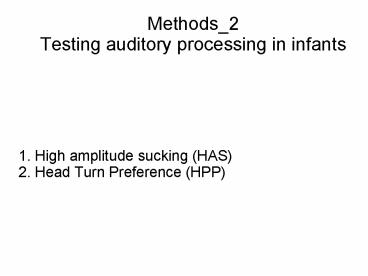Methods_2 Testing auditory processing in infants - PowerPoint PPT Presentation
1 / 14
Title:
Methods_2 Testing auditory processing in infants
Description:
French babies suck more/longer if they have heard Russian in the fam phase and ... Language discrimination by human newborns and by cotton-top tamarin monkeys. ... – PowerPoint PPT presentation
Number of Views:77
Avg rating:3.0/5.0
Title: Methods_2 Testing auditory processing in infants
1
Methods_2Testing auditory processing in infants
- 1. High amplitude sucking (HAS)
- 2. Head Turn Preference (HPP)
2
Methode High Amplitude Sucking (HAS)
- Dependent variable (Non-nutritive) Sucking rate
- (e.g., Mehler et al. 1988)
- subjects newborn French babies
- Procedure for experimental group
- 1. Baseline
- 2. Habituation phase Russian
- 3. Test phaseFrench
- French babies suck more/longer if they have
heard Russian in the fam phase and then hear
French in the test phase - --gt Language magnet effect
- (Control group Babies who heard F/F during fam
and test phase)
http//www.ehess.fr/centres/lscp/babylab/newborns.
html
3
The procedure The experiment takes place in a
sound-attenuated chamber. The infant is installed
in a reclining seat, and a flexible arm holds a
pacifier in his/her mouth. A pressure transducer
measures the air pressure inside the pacifier,
and sends the signal into a computer via an
analog/digital board. The experimentation program
detects sucks, computes their amplitude and plays
a stimulus back whenever a suck is considered as
having a high amplitude this is the high
amplitude sucking (HAS) procedure
http//www.ehess.fr/centres/lscp/babylab/newborns.
html
4
Typical habituation-test sequence
Habituation phase
Test phase
- Here, babies discriminated between Dutch and
Japanese resynthesized sentences (Ramus et al.,
2000
Ramus, F., Hauser, M. D., Miller, C., Morris, D.,
Mehler, J. (2000). Language discrimination by
human newborns and by cotton-top tamarin monkeys.
Science, 288(5464), 349-351.
5
Headturn Preference Procedure HPP...
- ... for testing
- auditory perception
Video of a HPP booth http//www.waisman.wisc.edu/i
nfantlearning/media/Room.mpg
http//www.acoustics.org/press/143rd/image006.jpg
people.bu.edu/leher/mom20and20baby.jpg
6
HPP characteristics
- Is suited for testing large samples of auditory
(speech) stimuli - Is suited for infants between 4 ½ and 12 months
- Takes advantage of the fact that babies
- visually orient towards a sound source
- maintain their headturn when motivating stimuli
are presented contingently on their behavior - Test whether infants prefer one stimulus (class)
over another - Produces a sensitive measure of infants'
discriminative abilities (Difference in time
attending to either stimulus)
7
The Procedure
- Preparation
- The green light in the middle flashes until the
baby orients towards it. An attractive puppet is
shown - The training/familiarization phase
- One of the red lights flashes until the baby
orients towards it - 4 (2x2) training trials each of the two stimuli
are presented on each side once. - The light extinguishes during stimulus
presentation - The test phase
- 12 (6x2) test trials random presentation of both
stimuli on either side. - The light remains on during stimulus
presentation - Between trials, the center stimulus (puppet) can
be shown as to refresh the infant's interest
8
The observer
- An observer monitors the infant's headturns
during the procedure, either through a
'peep-hole' or through the camera system, on a
monitor. - He/she operates a response box which controls the
presentation of the S and measures the
orienting/looking time by pressing on various
buttons. - He/she also shows the center stimulus
- The observer is 'blind' as to the experimental
conditions. He wears tight earphones and listens
to load music.
9
Objectivity
- Since the observer is 'blind' for the condition,
any experimenter bias can be excluded - If the session has been video-recorded, the
coding of the looking time can be repeated with
two independent coders whose inter-rater
reliability is determined. In the HPP, it is
usually high, around r .95. - There are automated programs which make coding
and determining inter-rater rel an easy job
10
Improvements of the HPP
- Many variations of the HPP have been tried out.
Improvements and extensions have been developed. - Formerly, stimulus and side were always coupled.
However, flexible allocation allows for a more
sensitive measure of infants' interest in the
stimuli which avoids confounds such as
side-preference - Formerly, only the direction of the headturn had
been measured. However, measuring the duration of
the orienting is a more sensitive measure
11
Variations and extensions of the HPP
- HPP can be used for within-subject comparisons if
two different versions of the same S-material are
administered. Thus, individual differences on the
level of a single subject can be analyzed - The trainings phase can be used as a
familiarization phase. In the test phase, the
retention of two kinds of stimuli can be tested,
depending on certain characteristics. - For example, infants hear isolated di-syllabic
words in the fam phase (either with the stress
pattern sw or ws). In the Test phase they hear
stories the sentences of which contain these
words. The HPP tests whether the infants realize
the previously heard words in the story, i.e.,
whether they can segment those target words.
12
Video of head-turn-preference procedure (J.
Saffran)
http//www.waisman.wisc.edu/infantlearning/parents
.htm
13
Example
- Discrimination of two native (German) syllables
ba vs. pa and two non-native syllables da
vs. da (Hindi retroflex)
14
References
- Kemler Nelson, Deborah G., Jusczyk, Peter W.,
Mandel, Denise R., Myers, James, Turk, Alice, and
Gerken, LouAnn (1995) The head-turn preference
procedure for testing auditory perception. Infant
Behavior and Development, 18, 111-116.































